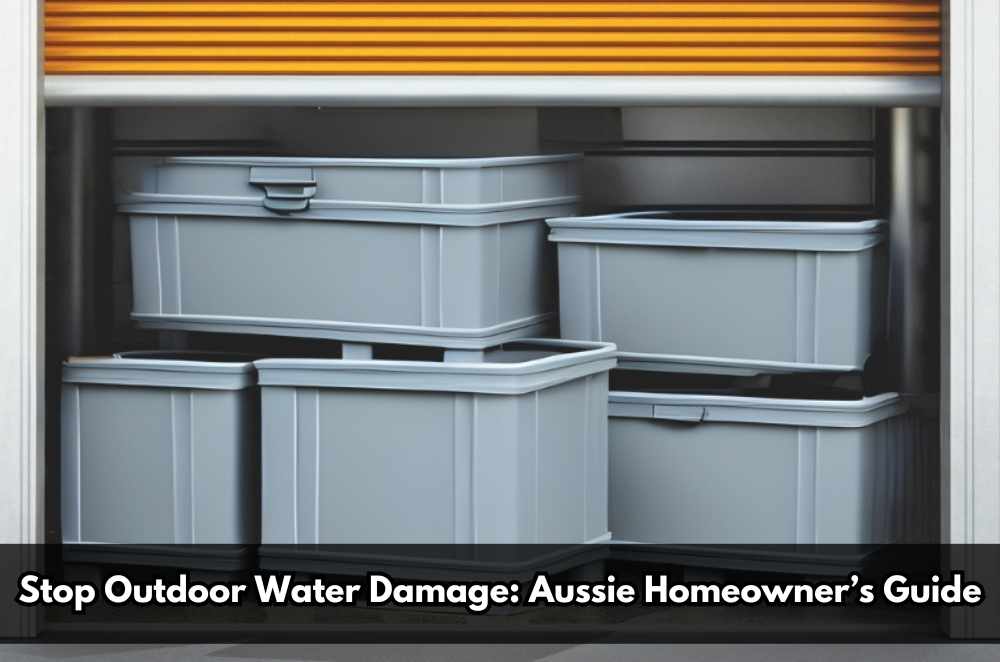
Outdoor living is a way of life in Australia. We host BBQs, stash tools on the back deck, and leave gear in the yard like it’s no big deal—until the weather turns. One heavy downpour and suddenly your cushions are soaked, power tools are rusting, and the kids’ toys smell like damp socks.
It’s not just annoying. Water damage costs Aussie homeowners thousands every year, especially when outdoor areas are poorly planned or unprotected. And the fix isn’t just building a shed or laying down a tarp. The smartest solution? Thinking in layers—starting with reliable outdoor waterproof storage solutions.
This guide walks you through real-world strategies to stop water damage before it starts—from budget-friendly upgrades to smarter storage, and even what the government has to say about doing it right.
Why outdoor water damage is such a pain
I learned this the hard way. A few years back, I left a cordless drill in what I thought was a sealed plastic tub near the garden shed. It rained overnight. The tub had warped from sun exposure. Next morning? A $300 paperweight.
What makes outdoor water damage so tricky is that it’s often invisible until it’s too late. It creeps in through cracks, sweats under covers, and seeps up through poorly drained slabs. And unlike indoor damage, it rarely qualifies for insurance claims.
Common issues include:
Warping of timber and composite materials
Rust and corrosion of metal tools and appliances
Mould growth on soft furnishings or cushions
Paint peeling on decks or fencing
Pest activity in damp boxes or bins
Water always finds a way, so your goal is to cut off every path.
The storage trap: Why most outdoor boxes fail
Just because something is labelled “outdoor storage” doesn’t mean it’s waterproof. I’ve seen boxes at hardware stores that look sturdy but leak through the lid seal or develop condensation inside.
Cheap plastic warps. Metal rusts. Wooden chests swell and split.
That’s why it’s important to invest in real outdoor waterproof storage solutions. These aren’t just boxes—they’re designed systems. They combine UV-resistant materials, proper drainage, venting, and sealed lids to protect what’s inside no matter the weather.
Features to look for:
Double-walled resin or UV-stabilised polyethylene
Sealed lid closures (not just clip-on lids)
Off-ground elevation or drainage feet
Lockable lids to keep pests out
Internal airflow to prevent condensation
Water damage hotspots around the home
Outdoor damage doesn’t just happen in backyards. Here are common areas where water builds up—and how to rethink them.
1. Deck boxes and patio furniture
Cushions, tools, gardening gloves—all thrown into storage between uses. But if your deck box isn’t sealed properly, moisture creeps in fast.
Fix: Use a storage box with a compression-sealed lid. Keep boxes elevated off decking boards to avoid pooling underneath.
2. Under eaves and awnings
Rain blows in sideways, and runoff can collect in unexpected spots—especially if gutters overflow.
Fix: Install rain diverters or splash guards. Avoid storing anything under low-clearance eaves unless it's inside a sealed container.
3. Garage corners and garden sheds
It’s tempting to treat the garage or shed like a catch-all. But these spots are often unsealed or poorly ventilated.
Fix: Use sealed bins, silica gel packs, and store tools vertically to keep water from pooling around them.
What Aussie regulations say about outdoor storage
Most people don’t realise there are actual rules around how outdoor storage should be handled, especially when it’s built-in or part of a larger structure.
NSW outdoor storage safety regulations outline important guidelines around:
Proper drainage and stormwater runoff
Non-combustible materials for high-risk zones
Adequate airflow for enclosed storage areas
Minimum height clearances and accessibility
If you’re planning to install a new structure—like a permanent storage cabinet or deck box—check with your local council first. Some require minor permits, especially if the storage unit is anchored or connected to a deck, wall, or slab.
Materials that handle Aussie weather better
Not all “weatherproof” materials live up to the label—especially in Australia’s intense climate.
Here’s what actually works:
Resin/plastic composite: UV-stable and rot-resistant, but choose brands that resist warping
Powder-coated aluminium: Lightweight, rust-resistant, good for sheds or tall cabinets
Marine-grade plywood: Can work if properly sealed and painted (needs regular maintenance)
Stainless steel: Strong, secure, but expensive—good for high-value tools or pool gear
Avoid cheap pine, unsealed MDF, or recycled plastics that don’t mention UV stability.
Thinking beyond the box: Smart ways to prevent damage
Sometimes the best defence isn’t storage—it’s prevention. Here are a few clever strategies I’ve picked up over the years:
Use rubber mats or pallets under storage boxes to improve airflow
Install shade sails or canopies to reduce sun exposure
Keep waterproof tarps handy for unexpected storms
Rotate storage seasonally—move tools indoors during storm season
And one that’s saved me more than once: invest in a cheap indoor humidity sensor. Stick it inside your outdoor storage box. If the reading spikes, you know there’s a seal issue before anything gets ruined.
What about renters?
Good question. Not everyone can drill into decks or install permanent outdoor storage. That doesn’t mean you’re out of luck.
Here are renter-friendly waterproof storage options:
Portable deck boxes with rubber seals
Weatherproof storage benches
Rolling plastic bins that fit under awnings
Stackable crates with zippered waterproof covers
Also, if you’re storing valuables outside (like camping gear or tools), keep a photo inventory in case anything gets damaged and you need to claim through contents insurance.
For more on keeping your gear in top condition, check out this guide on how to protect outdoor gear.
Why does all of this matter long-term
It’s easy to ignore outdoor water damage until it becomes a hassle. But small leaks and damp corners turn into:
Costly replacements
Pest infestations
Unsafe mould exposure
Reduced home value
On the flip side, smart waterproof storage extends the life of everything from BBQ tools to pool toys—and makes your outdoor space feel less like a dumping ground and more like an organised extension of your home.
Want more proof? Take a look at the benefits of waterproof storage, especially if you’ve got limited space or unpredictable weather.
Final thought: Don’t wait for the rain
The best time to waterproof is before things get wet.
Trust me—it’s far easier to choose proper outdoor waterproof storage solutions now than to dry out and replace everything after the fact.
Whether you own or rent, live coastal or inland, the logic’s the same: plan ahead, seal properly, and always assume the rain is coming sooner than expected.



Write a comment ...